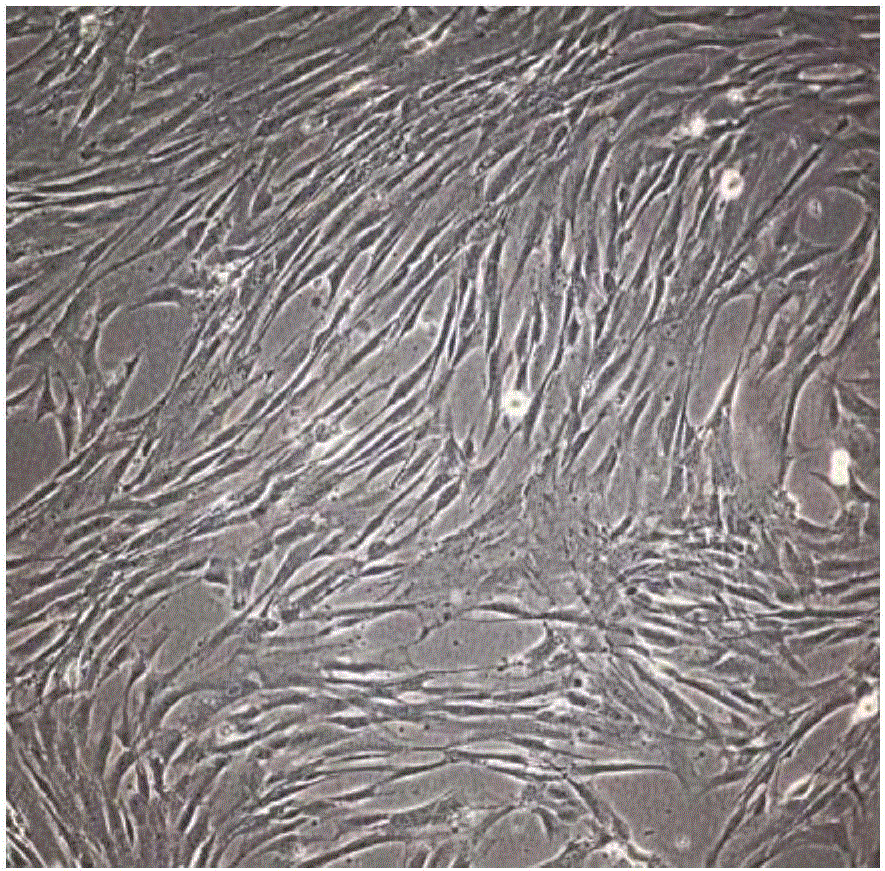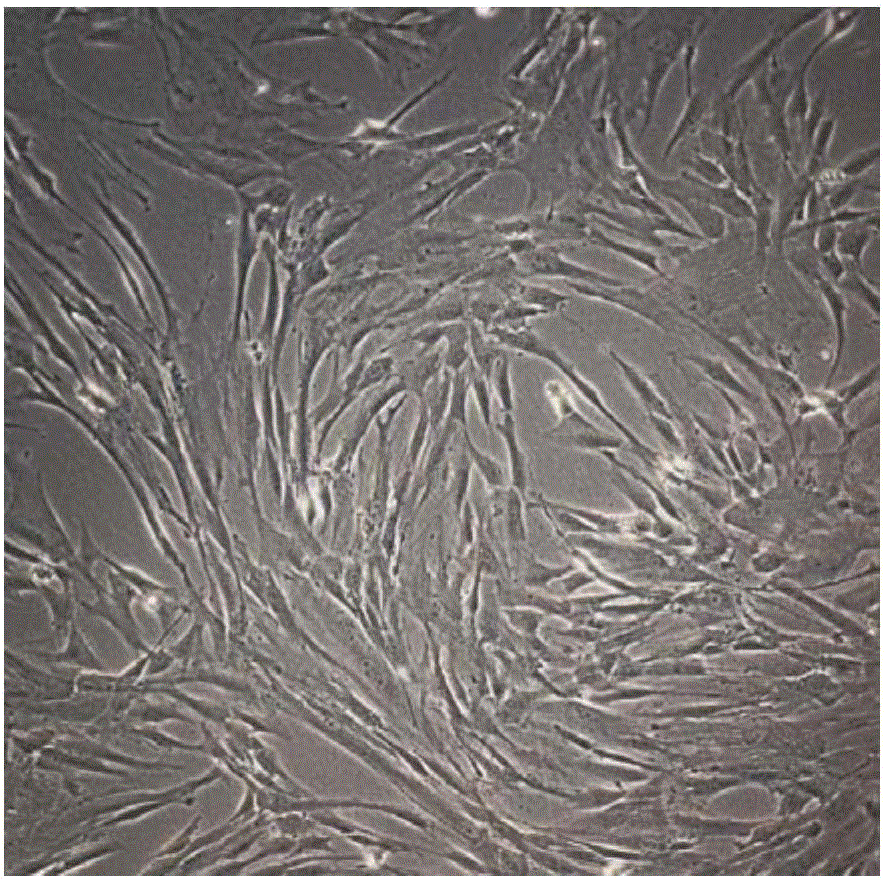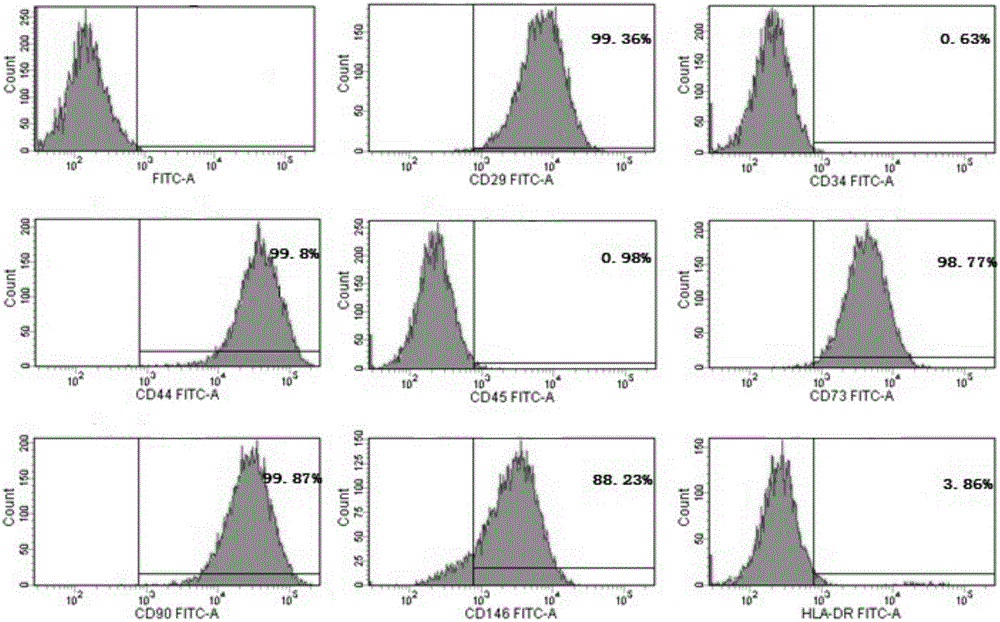Method for preparing and preserving umbilical arterial and vein vascular peripheral stem cells
A technology of venous blood vessels and umbilical cord blood vessels, applied in the field of bioengineering, can solve the problems of increasing the difficulty of umbilical cord processing, damage to cells, long cycle, etc., to avoid allergic reactions and cross-infection, strong osteogenic differentiation ability, and reduce cell damage. Effect
- Summary
- Abstract
- Description
- Claims
- Application Information
AI Technical Summary
Problems solved by technology
Method used
Image
Examples
Embodiment 1
[0028] (1) Under sterile conditions, take the umbilical cord of a newborn baby immediately after vaginal delivery from a healthy puerpera, about 30cm long, squeeze out the blood in the umbilical cord vessel, and put it into a container containing 5% blue chain double antibody and 1% heparin Store in a wide-mouthed bottle of PBS at 4°C, and isolate and culture umbilical cord mesenchymal stem cells within 4 hours;
[0029] (2) Take out the umbilical cord of the newborn, cut off the part with clamp marks and hematoma, squeeze out the blood in the umbilical cord, and trim the two sections with scissors. Use ophthalmic scissors to cut the umbilical cord longitudinally, use forceps to bluntly separate the venous blood vessels and arterial blood vessels, and pay attention to remove the tissue around the adventitia of the blood vessels that is close to the blood vessels;
[0030] (3) The umbilical artery and umbilical vein were washed with preheated PBS to completely remove the blood ...
Embodiment 2
[0038] (1) Under aseptic conditions, take the umbilical cord of a newborn baby immediately after the cesarean section of a healthy puerpera, about 40cm long, squeeze out the blood in the umbilical cord vessel, and put it into a container containing 5% blue chain double antibody and 1% heparin in advance Store in a wide-mouthed bottle of PBS at 4°C, and isolate and culture umbilical cord mesenchymal stem cells within 4 hours;
[0039] (2) Take out the umbilical cord of the newborn, cut off the part with clamp marks and hematoma, squeeze out the blood in the umbilical cord, and trim the two sections with scissors. Use ophthalmic scissors to cut the umbilical cord longitudinally, use forceps to bluntly separate the venous blood vessels and arterial blood vessels, and pay attention to remove the tissue around the adventitia of the blood vessels that is close to the blood vessels;
[0040] (3) The umbilical artery and umbilical vein were washed with preheated PBS to completely remo...
Embodiment 3
[0048] (1) Under aseptic conditions, take the umbilical cord of a newborn baby immediately after delivery from a healthy puerpera. Store in a jar of salt-buffered saline PBS at 4°C, and isolate and culture umbilical cord mesenchymal stem cells within 4 hours;
[0049] (2) Take out the umbilical cord of the newborn, cut off the part with clamp marks and hematoma, squeeze out the blood in the umbilical cord, and trim the two sections with scissors. Use ophthalmic scissors to cut the umbilical cord longitudinally, use forceps to bluntly separate the venous blood vessels and arterial blood vessels, and pay attention to remove the tissue around the adventitia of the blood vessels that is close to the blood vessels;
[0050] (3) The umbilical artery and umbilical vein were washed with preheated PBS to completely remove the blood stains. Use scissors to cut the umbilical vein and umbilical artery into small sections of about 0.5 cm, arrange them neatly in a 100 mm culture dish, and ...
PUM
 Login to View More
Login to View More Abstract
Description
Claims
Application Information
 Login to View More
Login to View More - R&D
- Intellectual Property
- Life Sciences
- Materials
- Tech Scout
- Unparalleled Data Quality
- Higher Quality Content
- 60% Fewer Hallucinations
Browse by: Latest US Patents, China's latest patents, Technical Efficacy Thesaurus, Application Domain, Technology Topic, Popular Technical Reports.
© 2025 PatSnap. All rights reserved.Legal|Privacy policy|Modern Slavery Act Transparency Statement|Sitemap|About US| Contact US: help@patsnap.com



